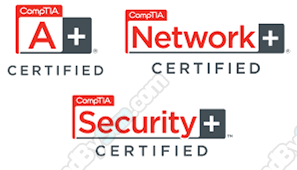Digital Download Immediately
 CompTIA A+ Certification - Michael C. Redman
CompTIA A+ Certification - Michael C. Redman
Become an A+ Certified PC Support Technician
In order to receive CompTIA A+ certification a candidate must pass two exams. The first exam is CompTIA A+ 220-901 Certification Exam. The CompTIA A+ 220-901 examination measures necessary competencies for an entry-level IT professional with the equivalent knowledge of at least 12 months of hands-on experience in the lab or field.
Successful candidates will have the knowledge required to:
- Assemble components based on customer requirements
- Install, configure and maintain devices, PCs and software for end users
- Understand the basics of networking and security/forensics
- Properly and safely diagnose, resolve and document common hardware and software issues
- Apply troubleshooting skills
- Provide appropriate customer support
- Understand the basics of virtualization, desktop imaging, and deployment
What does CompTIA A+ Certification - Michael C. Redman include?
CompTIA A+ Certification
- Chapter 01- The Path of the PC Tech (6:13)
- Chapter 02- Operational_Procedure (6:30)
- Chapter 03 - The Visable PC (13:01)
- Chapter 04 - Visible Windows (23:17)
- Chapter 05- Visible Networks (65:08)
- Chapter 06 - Microprocessors (20:08)
- Chapter 07- RAM (11:33)
- Chapter 08 - BIOS (8:32)
- Chapter 09 - Motherboards (6:04)
- Chapter 10- Power Supplies (15:30)
- Chapter 11- Hard Drive Technologies (22:26)
- Chapter 12- Implementing Hard Drives (32:21)
- Chapter 13- Removable Media (16:40)
- Chapter 14 - Installing and Upgrading Windows (31:23)
- Chapter 15 - Windows Under the Hood (41:35)
- Chapter 16 - NTFS Users (31:43)
- Chapter 17- Optimising Windows (35:54)rt
- Chapter 18- Command-Line (16:14)
- Chapter 19 - Troubleshooting Windows (32:06)
- Chapter 20 - Input Devices (19:00)
- Chapter 21 - Video (36:53)
- Chapter 22 - Local Area Networking (36:50)
- Chapter 23 - Wireless Networking (20:00)
- Chapter 24 - The Internet (23:31)
- Chapter 25 -Multimedia (15:59)
- Chapter 26 Portable Computing (35:20)
- Chapter 27 - Mobile Devices (14:03)
- Chapter 28 - Printers (34:12)
- Chapter 29 - Securing Computers (28:37)
- Chapter 30 - Virturalization (13:30)
- Chapter 31 - Build Your Own PC (22:35)